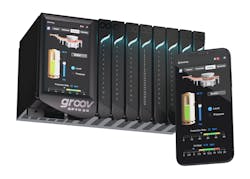The Industrial Internet of Things (IIoT) has certainly added fuel to the digital transformation that has been occurring in manufacturing. In fact, its promise is causing some to wonder how a long-established class of software—like manufacturing execution systems (MES)—will fare in the face of IIoT and other relatively new digital technologies. Will technologies like IIoT, cloud computing, and machine learning really make MESs obsolete?
Probably not, says Tom Hechtman, president and CEO of Sepasoft, who points out that an MES is not just a class of software. Even at its most fundamental level, it performs a core function within manufacturing by coordinating equipment, materials, and people to execute manufacturing operations. “So, every manufacturing facility has an MES somewhere,” argues Hechtman. “It might be on paper; it might be already digitalized. But MES doesn’t suddenly disappear just because we came up with this new thing called IIoT.” And he isn’t the only one arguing this point.
“MES is itself a digitalization initiative,” adds Luigi De Bernardini, president of Autoware Digital and CEO of Autoware, a certified Control System Integrators Association member. He sees MES as digitizing manufacturing execution management by collecting, manipulating, and disseminating data digitally to provide the right information, to the right people, at the right time so they can quickly make the best decisions.
An MES contributes to the digitalization of manufacturing operations in at least two important ways, according to Chris Rickey, global technical lead for MES at Rockwell Automation. “First, it provides the production context on which everything else hangs,” he says. In other words, the MES links all gathered data—quality metrics, genealogy, people, inventory, and other manufacturing resources—to a work order, lot, batch, or serial number. This context then forms the basis for a multidimensional matrix for analyzing production.
The second contribution that an MES makes to digitalization is to apply rules to this matrix to guide production. Rickey compares this contribution to a global positioning system (GPS) rerouting a driver based on driving conditions, closed roads, and current traffic. The MES can similarly adjust a process to accommodate current conditions by taking into account such factors as available inventory, equipment, and people. It can then guide an operator or other workers through the necessary steps and tasks in workflows.
IIoT enhances digitalization
Newer technologies like IIoT, cloud computing, machine learning, and artificial intelligence (AI) are tools that can help in implementing digital initiatives like MES. “They can be enablers,” notes De Bernardini. “They can help us to implement something that couldn’t be achieved before.”
However, he and others stress that these newer technologies are tools supporting digitalization initiatives and are not necessarily the initiative itself. IIoT, for example, is about interrelated devices sending and receiving data across a network. “It’s simply a communication path for data that needs to be used somehow,” explains Robert Miller, senior product manager at Mitsubishi Electric Automation.
“People like to talk about their IIoT projects and offerings,” Miller continues. “Too often, however, they don’t define the purpose of the project or the problem the offering solves. Using IIoT technology can help in a wide variety of applications, but it’s not the application.” He says this because IIoT cannot optimize production on its own. It can only enhance applications that have a way—such as an MES, enterprise resource planning system, or maintenance management system—to transform the data into actionable information.
Consequently, Miller thinks that the relationship between IIoT and MESs is analogous to that of industrial networking to supervisory control and data acquisition (SCADA). “Just as SCADA can use industrial networks for communication, so MES can similarly use IIoT-enabled devices to get or send information.”
This should not discount the growing role of IIoT and other technologies in manufacturing operations. “Some environments require more information and data collection functionalities, than they do management of operational activities,” says Keith Chambers, vice president of operations management software at Aveva. “In these cases, IIoT functionality, cloud computing, and data visualization and analyses might be taking over some of the functionality that a local MES had been providing.”
This is especially true in the process industries, according to Cathal Strain, CEO of Neo PLM, a provider of product lifecycle management solutions for pharmaceutical companies. “In process manufacturing, the MES has traditionally replaced paper-based work instructions—often by simply trading physical documents for electronic ones,” he says. “MES data, moreover, is often an unreliable source for accurate batch information, particularly event timestamps.” For these reasons, he believes that batch execution systems and recipe-based process control systems will take over more shop-floor execution as the digital transformation progresses in the process industries.
Working with digital twins
Even so, Chambers at Aveva notes that MESs have become central repositories for operational, maintenance, and engineering data—not only about individual assets within a plant, but also the manufacturing operations as a whole. In effect, the MES becomes the plant’s digital twin, an enabling concept in digitalization. “This twin allows for optimizing an asset’s operation and maintenance, either through internal applications or external digital services,” explains Chambers. It streamlines the application of technologies like artificial intelligence and machine learning to deliver predictive analytics and prescriptive planning and scheduling.
“The emergence of this twin is also enabling a transformation in how work is done and how people collaborate,” Chambers continues. He points to the mobile devices that assist in workflow management by giving workers access to work instructions and forms for data collection.
IIoT contributes to this effort by simplifying and reducing the costs of making the necessary connections within a plant and even across several locations. Although applying IIoT to “dumb” machines can get around the limitations of conventional technologies, Chambers notes that “IIoT is more fundamentally about the smart machine or the smart product.” As machines continue to gain intelligence and become the “things” in the IIoT, he sees MESs as the one place where a collection of smart machines can be connected to each other and to other assets, and can then be transformed into a smart factory.
Data from MESs can also simplify the development of machine-learning and artificial-intelligence applications. “Estimates are that as much as 80% of the effort in machine learning is spent preprocessing the data to clean it up,” says Hechtman. This effort is often unnecessary for data coming from an MES because the MES fits the data into a larger context, a process that tends to flag inaccurate data so that it can be fixed right away.
Another way that an MES can assist machine learning and AI is in the validation of results. “Machine learning and artificial intelligence must be trained against known valid answers,” notes Hechtman. “MES can be a great source. For example, it is common to feed key performance indicators such as OEE [overall equipment efficiency] to a machine learning platform.”
MES must evolve
For an MES to continue participating in an IIoT world, it will need to undergo some changes. “The core of the MES must be designed in such a way that it can scale with an ever-changing manufacturing process,” says Clint Wenthur, Sr., manager of global manufacturing systems engineering at Plexus. “An MES with additional deep learning components, for instance, will be able to identify complex trends that identify the next best step versus just notifications.”
Many of the big, legacy MESs will also need modernization with IIoT-protocol-enabled microservices. “This will allow the MES to continue to manage the production rules, but allow an IIoT front-end to make use of those services to suit the situation while the MES ensures the rules are followed,” adds Rickey.
Hechtman sees conventional communication models of polling devices for information as being inadequate in an IIoT world. He instead recommends that MESs use open communications protocols like OPC UA (OPC Unified Architecture) and MQTT (message queuing telemetry transport). “Proprietary systems and data being in islands will not work for the future,” he says.
Rickey predicts that the line between MES and some aspects of IIoT will blur until they are one and the same, much like how enterprise resource planning (ERP) consolidated many enterprise functions. “MES will take on many of the quick-connect integration capabilities of IIoT, and IIoT tools will continue to include workflow tools and data models that support product context,” he says.
Controls vendors have been helping here by adapting their hardware to support the IIoT. These edge devices can gather and preprocess IIoT data and communicate native IIoT data up to systems like an MES. “It is a significant enhancement because it reduces complexity while addressing security,” says Garrick Reichert, senior applications engineer at Opto 22. “The more information a device at the edge can process and deliver up to business systems, the more informed the MES and the people using it can become.”
Some vendors have been updating their MESs for an environment that will be created by blurring the line between IIoT and conventional operational technologies like programmable logic controllers (PLCs), human-machine interfaces (HMIs), and SCADA systems. Chambers, for example, reports that Aveva is developing functionality for connecting to edge or IIoT devices and consolidating data in the cloud.
“We are already offering newly developed, native MES cloud applications with the ability to connect with existing plant systems or IIoT-enabled devices using IoT and edge technologies,” he says. “We will continue to provide both on-premise MES and cloud MES applications with the ability to mix and match the best of both for a foggy or hybrid cloud solution.”
Because De Bernardini views MESs as tools for empowering workers, he believes that users and vendors should focus on streamlining communications among people and machines. The focus should be on exchanging information with an MES in ways that people find natural. An example is the chat-like application that one of his customers implemented. “The participants in the chat sessions are both people and machines,” recounts De Bernardini.
He also reports that his company is exploiting AI in its work on an Alexa-like digital assistant for its MES. “You almost don’t recognize that you are talking with a bot, instead of a human being,” he says. “Using it, you can ask your MES for information about production, such as the performance of a shift or machine, how much waste you had, or what kind of initiatives you need to take. It will change the way that people and the machine interact.”
Leaders relevant to this article:




